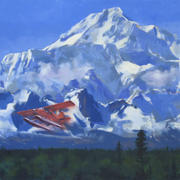Due to a lapse in appropriations, the majority of USGS websites may not be up to date and may not reflect current conditions. Websites displaying real-time data, such as Earthquake and Water and information needed for public health and safety will be updated with limited support. Additionally, USGS will not be able to respond to inquiries until appropriations are enacted. For more information, please see www.doi.gov/shutdown
Mission Areas
Energy and Minerals
Mission Areas L2 Landing Page Tabs
Populations of concern: Chapter 9
Climate change is already causing, and is expected to continue to cause, a range of health impacts that vary across different population groups in the United States. The vulnerability of any given group is a function of its sensitivity to climate change related health risks, its exposure to those risks, and its capacity for responding to or coping...
Gamble, Janet; Balbus, John; Berger, Martha; Bouye, Karen; Campbell, Vince; Chief, Karletta; Conlon, K.; Crimmins, Allison; Flanagan, Barry; Gonzalez-Maddux, C.; Hallisey, E.; Hutchins, S.; Jantarasami, L.; Khoury, S.; Kiefer, M.; Kolling, J.; Lynn, K.; Manangan, A.; McDonald, M.; Morello-Frosch, R.; Hiza, Margaret; Sheffield, P.; Thigpen Tart, K.; Watson, J.; Whyte, K.P.; Wolkin, A.F.Nonmarine facies in the Late Triassic(?) to Early Jurassic Horn Mountain Tuff member of the Talkeetna Formation, Horn Mountain, lower Cook Inlet basin, Alaska
The Talkeetna Formation is a prominent lithostratigraphic unit in south-central Alaska. In the Iniskin–Tuxedni area, Detterman and Hartsock (1966) divided the formation into three mappable units including, from oldest to youngest, the Marsh Creek Breccia, the Portage Creek Agglomerate, and the Horn Mountain Tuff Members. The Horn Mountain Tuff...
LePain, D.L.; Stanley, Richard G.; Helmold, K.P.Reconnaissance stratigraphy of the Red Glacier Formation (Middle Jurassic) near Hungryman Creek, Cook Inlet basin, Alaska
Geochemical data suggest the source of oil in upper Cook Inlet fields is Middle Jurassic organic-rich shales in the Tuxedni Group (Magoon and Anders, 1992; Lillis and Stanley, 2011; LePain and others, 2012, 2013). Of the six formations in the group (Detterman, 1963), the basal Red Glacier Formation is the only unit that includes fine-grained rocks...
LePain, D.L.; Stanley, Richard G.; Helmold, K.P.Sedimentary petrology and reservoir quality of the Middle Jurassic Red Glacier Formation, Cook Inlet forearc basin: Initial impressions
The Division of Geological & Geophysical Surveys and Division of Oil & Gas are currently conducting a study of the hydrocarbon potential of Cook Inlet forearc basin (Gillis, 2013, 2014; LePain and others, 2013; Wartes, 2015; Herriott, 2016 [this volume]). The Middle Jurassic Tuxedni Group is recognized as a major source of oil in Tertiary...
Helmold, K.P.; LePain, D.L.; Stanley, Richard G.U.S. Geological Survey assessment of global potash production and resources—A significant advancement for global development and a sustainable future.
During the past 15 yr, the global requirement for fertilizers has grown considerably, mainly due to demand by a larger and wealthier world population for more and higher-quality food. The demand and price for potash as a primary fertilizer ingredient have increased in tandem, because of the necessity to increase the quantity and quality of food...
Cocker, Mark D.; Orris, Greta J.; Wynn, JeffThe Bonneville Flood—A veritable débâcle: Chapter 6
The Bonneville Flood was one of the largest floods on Earth. First discovered by G.K. Gilbert in the 1870s during his inspection of the outlet at Red Rock Pass, it was rediscovered in the 1950s by Harold Malde and coworkers, leading to mapping and assessment of spectacular flood features along Marsh Creek, Portneuf River, and Snake River for over...
O'Connor, Jim E.Potash—A vital agricultural nutrient sourced from geologic deposits
This report summarizes the primary sources of potash in the United States. Potash is an essential nutrient that, along with phosphorus and nitrogen, is used as fertilizer for growing crops. Plants require sufficient potash to activate enzymes, which in turn catalyze chemical reactions important for water uptake and photosynthesis. When potassium...
Yager, Douglas B.Age, distribution and style of deformation in Alaska north of 60°N: Implications for assembly of Alaska
The structural architecture of Alaska is the product of a complex history of deformation along both the Cordilleran and Arctic margins of North America involving oceanic plates, subduction zones and strike-slip faults and with continental elements of Laurentia, Baltica, and Siberia. We use geological constraints to assign regions of deformation to...
Moore, Thomas E.; Box, Stephen E.Bedrock morphology and structure, upper Santa Cruz Basin, south-central Arizona, with transient electromagnetic survey data
The upper Santa Cruz Basin is an important groundwater basin containing the regional aquifer for the city of Nogales, Arizona. This report provides data and interpretations of data aimed at better understanding the bedrock morphology and structure of the upper Santa Cruz Basin study area which encompasses the Rio Rico and Nogales 1:24,000-scale U....
Bultman, Mark W.; Page, William R.Sedimentary exhalative (sedex) zinc-lead-silver deposit model
This report draws on previous syntheses and basic research studies of sedimentary exhalative (sedex) deposits to arrive at the defining criteria, both descriptive and genetic, for sedex-type deposits. Studies of the tectonic, sedimentary, and fluid evolution of modern and ancient sedimentary basins have also been used to select defining criteria....
Emsbo, Poul; Seal, Robert R.; Breit, George N.; Diehl, Sharon F.; Shah, Anjana K.Probing the volcanic-plutonic connection and the genesis of crystal-rich rhyolite in a deeply dissected supervolcano in the Nevada Great Basin: Source of the late Eocene Caetano Tuff
Late Cenozoic faulting and large-magnitude extension in the Great Basin of the western USA has created locally deep windows into the upper crust, permitting direct study of volcanic and plutonic rocks within individual calderas. The Caetano caldera in north–central Nevada, formed during the mid-Tertiary ignimbrite flare-up, offers one of the best...
Watts, Kathryn E.; John, David A.; Colgan, Joseph P.; Henry, Christopher D.; Bindeman, Ilya N.; Schmitt, Axel K.Geology and mineral resources of the North-Central Idaho Sagebrush Focal Area: Chapter C in Mineral resources of the Sagebrush Focal Areas of Idaho, Montana, Nevada, Oregon, Utah, and Wyoming
SummaryThe U.S. Department of the Interior has proposed to withdraw approximately 10 million acres of Federal lands from mineral entry (subject to valid existing rights) from 12 million acres of lands defined as Sagebrush Focal Areas (SFAs) in Idaho, Montana, Nevada, Oregon, Utah, and Wyoming (for further discussion on the lands involved see...
Lund, Karen; Zürcher, Lukas; Hofstra, Albert H.; Van Gosen, Bradley S.; Benson, Mary Ellen; Box, Stephen E.; Anderson, Eric D.; Bleiwas, Donald I.; DeAngelo, Jacob; Drake, Ronald M.; Fernette, Gregory L.; Giles, Stuart A.; Glen, Jonathan M. G.; Haacke, Jon E.; Horton, John D.; John, David A.; Robinson, Gilpin R.; Rockwell, Barnaby W.; San Juan, Carma A.; Shaffer, Brian N.; Smith, Steven M.; Williams, Colin F.The Southern High Plains
The Southern High Plains of New Mexico, Oklahoma, and Texas. USGS conducted a uranium assessment in this region in 2015.
The Southern High Plains
The Southern High Plains of New Mexico, Oklahoma, and Texas. USGS conducted a uranium assessment in this region in 2015.
Uranium-Vanadate Mineral in Calcrete
A uranium-vanadate mineral in calcrete. This sample came from near the Sulfur Springs Draw in Texas. USGS conducted an assessment of uranium resources in this region in 2015.
Shearing of the Melozitna Granite
Geologist and cataclastic shear zones in the Melozitna granite in the Ruby batholith. This granite contains abundant monazite and high levels of thorium and rare earth elements. The shear zones accelerate erosion of the granite into streams, where the monazite that contains the rare earth elements can be concentrated. This area is part of the Bureau of Land Management's
...Collecting a Gas Hydrate Research Core from the Indian Ocean
Scientists aboard the D/S Chikyu prepare to collect a research core drilled from marine sediments in the Indian Ocean. This research is part of the 2015 Indian National Gas Hydrate Program Expedition 02 (NGHP-02), which is a follow-up to the 2006 NGHP-01.
NGHP-02 identified several large deposits of potentially producible gas hydrates in the Indian
...Panning for Rare Earths
A USGS geologist pans for monazite and rare earth minerals in Wolf Creek, which cuts through the Melozitna granite. This area is part of the Bureau of Land Management's Central Yukon Planning Area, which USGS did a mineral assessment of in 2015.
Scanning Electron Microscope Image of Finchite
A scanning electron microscope image of the newly discovered mineral finchite. The Denver Microbeam Lab provided this scan of finchite in order to help describe and identify the mineral as a new one. Finchite is a uranium mineral first observed in Martin County, Texas. Read more about our uranium research here
...Finchite Mineral
A sample of finchite, a newly discovered uranium mineral. Finchite is the yellow material on the surface of the rock. Finchite is found in the late Pleistocene sediments deposited during the Illinoian glacial stage. It was first observed in Martin County, Texas. Read more about our uranium research here.
...Finchite Mineral
A sample of finchite, a newly discovered uranium mineral. Finchite is the yellow material on the surface of the rock. Finchite is found in the late Pleistocene sediments deposited during the Illinoian glacial stage. It was first observed in Martin County, Texas. Read more about our uranium research here.
...USGS Scientist Examining Texas Rock Layers for Finchite Minerals
USGS scientist Bradley Van Gosen examines rock layers for the newly discovered mineral finchite near Lamesa, Texas. Van Gosen was the first to recognize the existence of the new mineral, which was named for long-time USGS uranium geologist Warren Finch. Read more about our uranium research here.
USGS Scientists Seeking Finchite by the Sulfur Springs Draw in Texas
Between Lamesa and Big Spring, Texas, runs the Sulfur Spring Draw, a dry creek. It's the site of an economic calcrete-type uranium deposit, the Sulfur Springs Draw Deposit, where a new mineral was discovered in 2015. The mineral, first observed by USGS scientist Bradley Van Gosen, is a uranium-mineral named finchite after long-time USGS uranium geologist Warren Finch. Read
...USGS Publication on Iran’s Nonfuel Minerals Industry Released
The USGS released a publication highlighting the nonfuel minerals industry of Iran.
EarthView–Landsat Reveals Industrial Growth in Powder River Basin
Landsat shows how coal development in the Powder River Basin has changed the landscape since 1984...
Hyperspectral Surveying: A Tool for Assessing the Mineral Potential of Alaska
Alaska is a major producer of base and precious metals and has a high potential for additional undiscovered mineral resources. However, discovery is hindered by Alaska’s vast size, remoteness and rugged terrain. New methods are needed to overcome these obstacles in order to evaluate Alaska’s geology and mineral resource potential.
New USGS Alaska Geochemical Atlas Tells Rich Tales About the Last Frontier
The U.S. Geological Survey has produced a new compilation of landscape-scale sediment and soil geochemical data for Alaska. This was last completed nearly 40 years ago in 1978, but the new effort uses modern modeling and analysis techniques to map 68 elements across a newly developed and updated geochemical atlas of Alaska.
USGS Estimates 66 Trillion Cubic Feet of Natural Gas in Colorado’s Mancos Shale Formation
This is the second-largest assessment of potential shale & tight gas resources that the USGS has ever conducted.
Evidence of Unconventional Oil and Gas Wastewater Found in Surface Waters near Underground Injection Site
These are the first published studies to demonstrate water-quality impacts to a surface stream due to activities at an unconventional oil and gas wastewater deep well injection disposal site.
EarthWord - Mother Lode
Happy Mother's Day from EarthWords!
USGS Continues to Write History
The fourth volume of the comprehensive history of the U.S. Geological Survey, Minerals, Lands, and Geology for the Common Defence and General Welfare: Volume 4, 1939‒1961, has been issued as an electronic document.
Special Review and Webinar Showcase Critical Minerals Research at USGS
Scientists studying rare earth and critical elements now have a solid foundation for future research, as detailed in a special volume of the Society of Economic Geologists. This review volume, featuring several papers authored and co-authored by the U.S. Geological Survey, provides a comprehensive review of the current state of knowledge for rare earth and critical elements in ore deposits.
USGS Assesses 39–54 Billion Metric Tons of Undiscovered Potash Resources in Central Asia
The Central Asia Salt Basin of Turkmenistan, Uzbekistan, Tajikistan and Afghanistan has the potential to contain between 39 and 54 billion metric tons of undiscovered potash resources, according to a global mineral resource assessment led by the U.S. Geological Survey (USGS). Known potash resources in the Central Asia Salt Basin consist of 1.63 billion metric tons.
Multidisciplinary Science Addresses Complex Resource and Environmental Issues
The ongoing resource, climate, hazards and environmental issues of the United States are addressed in a new U.S. Geological Survey product, providing an overview of the USGS Mineral Resources Program's multidisciplinary science.
EarthWord – Ore
The naturally occurring material from which a mineral or minerals of economic value can be extracted. Usually minerals, especially metals, are mined first in ore form, then refined later.

































